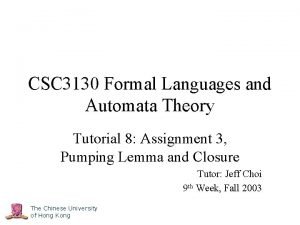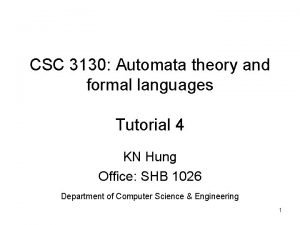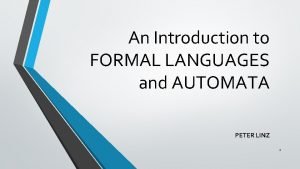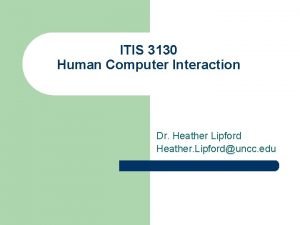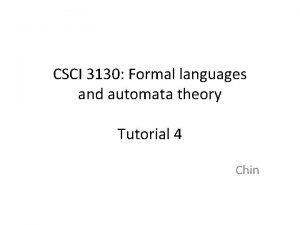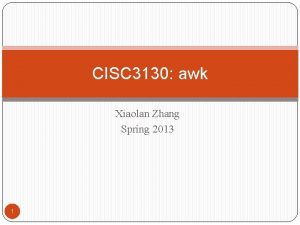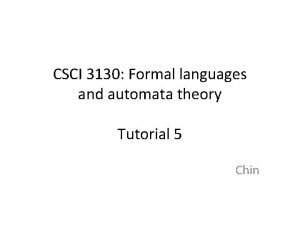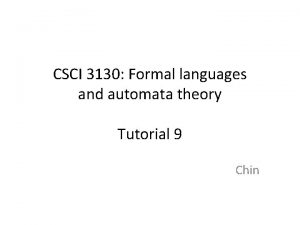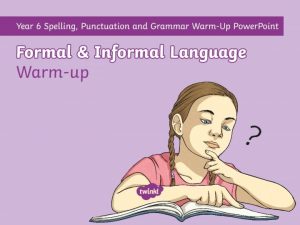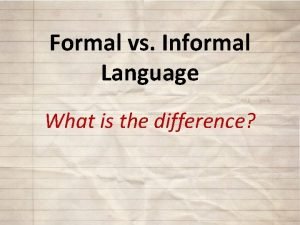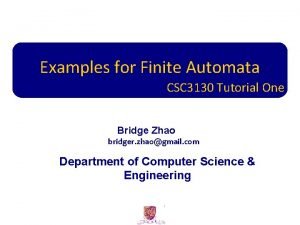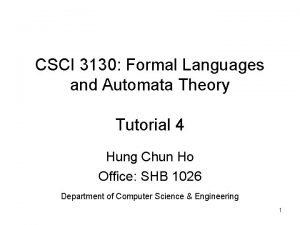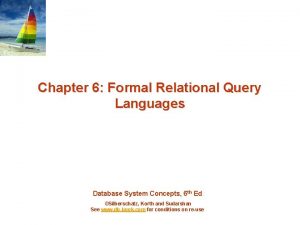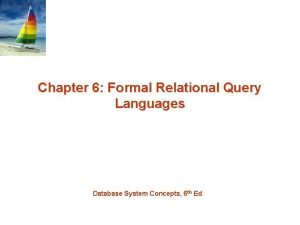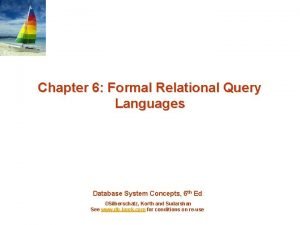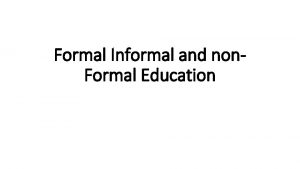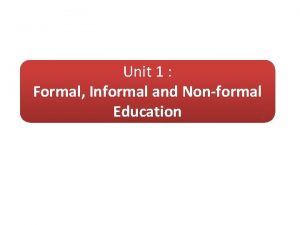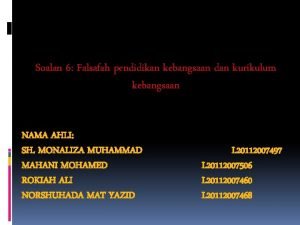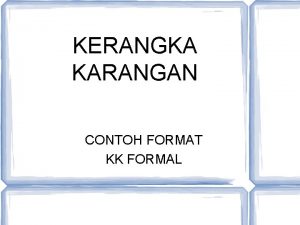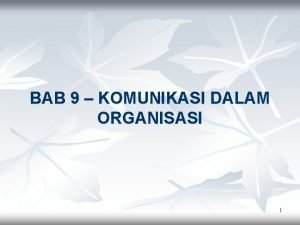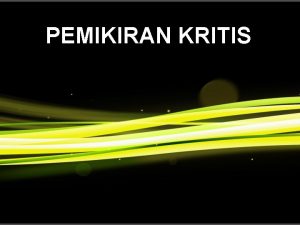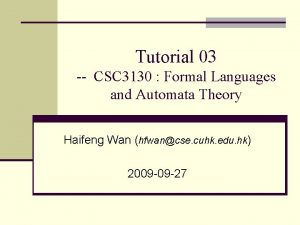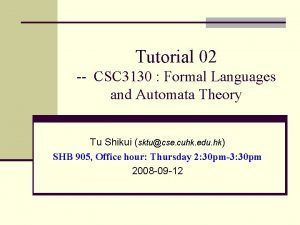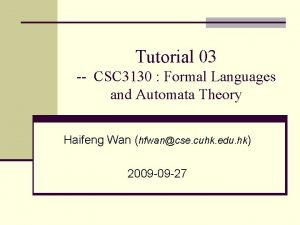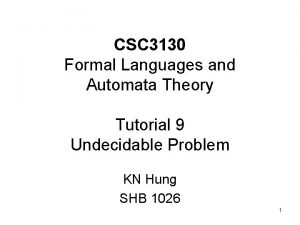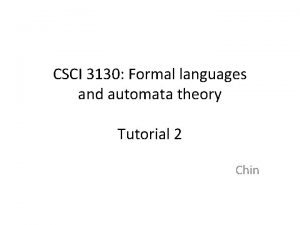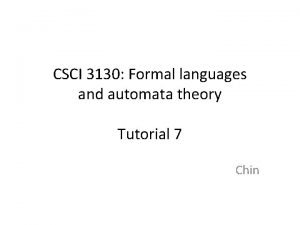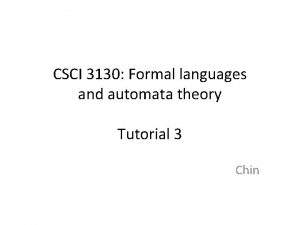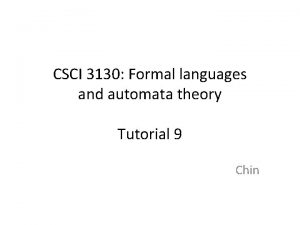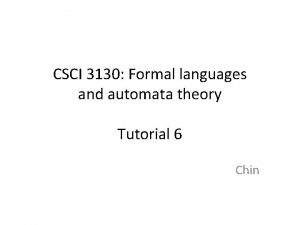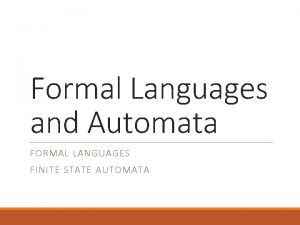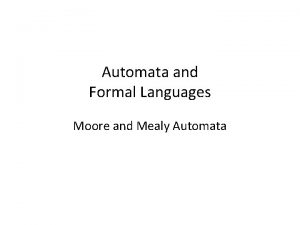Tutorial 05 CSC 3130 Formal Languages and Automata






























- Slides: 30

Tutorial 05 -- CSC 3130 : Formal Languages and Automata Theory Tu Shikui (sktu@cse. cuhk. edu. hk) SHB 905, Office hour: Thursday 2: 30 pm-3: 30 pm 2008 -10 -06

Outline n Context-free Languages, Context-free grammars (CFG), Push-down Automata (PDA) n Grammar Transformations Remove ε- production; n Remove unit-production; n Covert to Chomsky-Normal-Form (CNF) n n Cocke-Younger-Kasami (CYK) algorithm

Relations Context-free Languages L L = L(G) Context-free Grammars G L(G) = L(M) L = L(M) Push-down Automata M

Example (I) n Given the following CFG Σ={a, b} S X | Y X a. Xb | a. X | a Y a. Yb | b n (1) L(G) = ? n (2) Design an equivalent PDA for it.

Example (I) --- solution: L(S) S X|Y X a. Xb | a. X | a Y a. Yb | b Try to write some strings generated by it: S X a. Xb aa. Xbb aaaabb more a’s than b’s S Y a. Ybb aa. Ybbb aabbbb more b’s than a’s Observations: • Start from S, we can enter two States X & Y, and X, Y are “independent”; Ls = Lx U Ly • In X state, always more a are generated; Lx = { aibj; i>j } • In Y state, always more b are generated. Lx = { aibj; i<j } L(S) = { aibj; i≠j }

Example (I) --- solution: PDA L(S) = { aibj; i≠j } ={ a ib j; i>j } U { a ib j; S X| Y X a. Xb | a. X Y a. Yb | Yb i<j } | a | b PDA = NFA + a stack (infinite memory) A possible way: “divide and conquer” Lx = { aibj; i>j } a, /A , /# q’ 0 , A/ b, A/ , / q’ 1 LY = { aibj; i<j } , A/ q’ 2 , #/ a, /A q’ 3 , /# , / Combine both … q 0 , / b, A/ q 1 b, #/# q 2 , #/ q 3

Example (II) n Given the following language: L = {0 i 1 j: i ≤ j ≤ 2 i, i=0, 1, …}, n (1) design a CFG for it; n (2) design a PDA for it. S = {0, 1}

Example (II) -- solution: CFG L = {0 i 1 j: i ≤ j ≤ 2 i, i=0, 1, …}, 1} S = {0, Consider two extreme cases: (a). if j = i, then L 1 = { 0 i 1 j: i=j }; (b). if j = 2 i, then L 2 = { 0 i 1 j: 2 i=j }. S 0 S 1 “red-rule” S ε S 0 S 11 S ε If i ≤ j ≤ 2 i , then randomly choose “redrule” or “blue-rule” in the generation. S 0 S 11 S ε “blue-rule”

Example (II) -- solution: CFG L = {0 i 1 j: i ≤ j ≤ 2 i, i=0, 1, …}, S = {0, 1} Need to verify L = L(G) G= S 0 S 11 S ε 1). L(G) is a subset of L: The “red-rule” and “blue-rule” guarantee that in each derivation, the number of 1 s generated is one or two times larger than that of 0 s. So, L(G) is a subset of L. 2). L is a subset of L(G): For any w = 0 i 1 j, i ≤ j ≤ 2 i, we use “red-rule” (2 i - j) times and then “blue-rule” ( j - i ) times, i. e. , S =*=> 02 i-j. S 12 i-j =*=> 02 i-j 0 j-i. S 12(j-i)12 i-j ==> 0 i 1 j = w

Example (II) -- solution: PDA L = {0 i 1 j: i ≤ j ≤ 2 i, i=0, 1, …}, S = {0, Similar idea: 1} “randomly choose two extreme cases” 1, X/ 0, /X , /# q 1 , / , #/ q 0 1, X/X 1, X/ q 2 q 3

Example (III) n Given the following language: L = { aibjckdl: i, j, k, l=0, 1, …; i+k=j+l }, where the alphabet Σ= {a, b, c, d} n (1). Design a CFG for it; n (2). Design a PDA for it.

Example (III) – solution: CFG L = { aibjckdl: i, j, k, l=0, 1, …; i+k=j+l }, Note that i + k = j + l ==> | i – j | = | l – k |. Assume n = i – j = l – k > 0, then i = n + j, l = n + k, and w = aibjckdl = anaj bj ckdkdn S a. Sd | XY w Three blocks come from the same template: an dn N x. Nx X a. Xb | ε Y c. Yd | ε S=*=>an. Sdn=*=> an. XYdn ajbj ckdk =*=>anajbj. Ydn =*=>anajbj ckbkdn aj bj ck dk = an+jbj ckbn+k (n+j) + k = j + (n+k)

Example (III) – solution: PDA L = { aibjckdl: i, j, k, l=0, 1, …; i+k=j+l }, Main idea: (1) use X to record an a or c; use Y to record an b or d. (2) Compare #X and #Y: by cancellation. How to realize the comparison by cancellation? Action 1: Push an X, when a or c was read; Action 2: Pop an X (if any, otherwise push a Y), when b or d was read. Action 3: Pop an Y (if any, otherwise push an X), when a or c was read.

Example (III) – solution: PDA L = { aibjckdl: i, j, k, l=0, 1, …; i+k=j+l }, Action 1: Push an X, when a or c was read; Action 2: Pop an X (if any, otherwise push a Y), when b or d was read. Action 3: Pop an Y (if any, otherwise push an X), when a or c was read. b, X/ a, /X , /# q 1 c, #/X# c, X/XX , / q 2 b, #/Y# b, Y/YY , / q 3 c, Y/ , / d, X/ q 4 d, #/Y# d, Y/YY , #/ q 5

Outline n Context-free Languages, Context-free grammars (CFG), Push-down Automata (PDA) n Grammar Transformations Remove ε- production; n Remove unit-production; n Covert to Chomsky-Normal-Form (CNF) n n Cocke-Younger-Kasami (CYK) algorithm

Remove ε-production n Example: Remove ε-productions of the following grammar G: S ABa. C A BC B b |ε C D |ε D d

Remove ε-production Nullable variables: A, B, C S ABa. C | Aa. C | ABa | Aa | a A BC | B B b |ε C D |ε D d Add For A: S Ba. C For B: S Aa. C | a. C Delete B ε A C For C: S ABa | Aa | a A B For i = 1 to k For every production of the form A → Ni , add another production A → If Ni → is a production, remove it C ε

Remove unit-productions n Example: Remove the unit-productions of the following grammar: S S+T|T T T*F |F F (S) | a

Remove unit-productions Add S S+T | T*F | a | (S) T T*F | a | (S) F (S) | a Delete S T For T T*F For T F a For T F (S) S T*F S a S (S) T F For F a For F (S) S a S (S) Rule 1: A 1 → A 2 →. . . → Ak → A 1 delete it and replace everything with A 1 Rule 2: A 1 → A 2 →. . . → Ak → A 1 → , . . . , Ak →

Convert CFG to Chomsky-Normal. Form (CNF) n Example: Convert the following CFG to CNF: S 0 AB A 0 D | 1 AD B 0 D 1

Convert CFG to Chomsky-Normal. Form (CNF) A → Bc. DE replace terminals with new variables S 0 AB A 0 D | 1 AD B 0 D 1 A → BCDE C→c break up sequences with new variables A → BX 1 → CX 2 → DE C→c S XAB; X 0 A XD | YAD; Y 1

Convert CFG to Chomsky-Normal. Form (CNF) A → Bc. DE replace terminals with new variables S XAB X 0 A XD |YAD Y 1 B 0 D 1 A → BCDE C→c break up sequences with new variables S XN 1; N 1 AB A YN 2; N 2 AD A → BX 1 → CX 2 → DE C→c

Convert CFG to Chomsky-Normal. Form (CNF) A → Bc. DE replace terminals with new variables A → BCDE C→c S XN 1 AB A XD A YN 2 AD X 0 Y 1 B 0 D 1 break up sequences with new variables A → BX 1 → CX 2 → DE C→c

Outline n Context-free Languages, Context-free grammars (CFG), Push-down Automata (PDA) n Grammar Transformations Remove ε- production; n Remove unit-production; n Covert to Chomsky-Normal-Form (CNF) n n Cocke-Younger-Kasami (CYK) algorithm

Cocke-Younger-Kasami (CYK) algorithm n Constructing the parse table n Input: w = a 1 a 2…an ∈ Σ+ n Output: The parse table T for w such that tij contains A ⇔ A +⇒ aiai+1…ai+j-1 n Steps: n n n Step(1): cell(i, 1) = { A | A→ai ∈ P, 1≤i≤n } Step(2): for 1 ≤ k < j, cell(i, j) = { A | for some k, A→BC ∈ P, B is in cell(i, k), C is in cell(i+k, j-k) } Step(3): repeat Step(2) for 1≤ i≤ n, 1≤ j ≤ n-i+1

Cocke-Younger-Kasami (CYK) algorithm j=5 cell 11, cell 24 cell 12, cell 33 cell 13, cell 42 cell 14, cell 51 Cell (i, k), Cell (i+k, j-k) k = 1, …, j-1 j=4 cell 11, cell 23 cell 12, cell 32 cell 13, cell 41 cell 21, cell 33 cell 22, cell 42 cell 23, cell 51 j=3 cell 11, cell 22 cell 12, cell 31 cell 21, cell 32 cell 22, cell 41 cell 31, cell 42 cell 32, cell 51 j=2 cell 11, cell 21, cell 31, cell 41 j=1 A 1 x 1 A 2 x 2 i=1 i=2 x 1 x 2 cell 41, cell 51 A 3 x 3 A 4 x 4 A 5 x 5 i=3 x 3 i=4 x 4 i=5 x 5

Cocke-Younger-Kasami (CYK) algorithm j=5 cell 11, cell 24: S, A cell 12, cell 33: S, A cell 13, cell 42: S, A cell 14, cell 51: S, A j=4 cell 11, cell 23: S, A cell 12, cell 32: S, A cell 13, cell 41: S, A cell 21, cell 33: A cell 22, cell 42: S, A cell 23, cell 51: -- j=3 cell 11, cell 22 : S cell 12, cell 31: A, S cell 21, cell 32: -cell 22, cell 41: S cell 31, cell 42: S, A cell 32, cell 51: -- j=2 cell 11, cell 21: S, A cell 21, cell 31: A cell 31, cell 41: S j=1 A 1 x 1 : A A 2 x 2 : S A 3 x 3 : A i=1 i=2 i=3 a S → AA | AS | b A → SA | AS | a b Test: w = abaab a cell 41, cell 51: S, A A 4 x 4 : A A 5 x 5 : S i=4 a i=5 b

Cocke-Younger-Kasami (CYK) algorithm Trace back to find a parse tree j=5 cell 11, cell 24: S, A cell 12, cell 33: S, A cell 13, cell 42: S, A cell 14, cell 51: S, A j=4 cell 11, cell 23: S, A cell 12, cell 32: S, A cell 13, cell 41: S, A cell 21, cell 33: A cell 22, cell 42: S, A cell 23, cell 51: -- j=3 cell 11, cell 22 : S cell 12, cell 31: A, S cell 21, cell 32: -cell 22, cell 41: S cell 31, cell 42: S, A cell 32, cell 51: -- j=2 cell 11, cell 21: S, A cell 21, cell 31: A cell 31, cell 41: S j=1 A 1 x 1 : A A 2 x 2 : S A 3 x 3 : A i=1 i=2 i=3 a S → AA | AS | b A → SA | AS | a b Test: w = abaab a cell 41, cell 51: S, A A 4 x 4 : A A 5 x 5 : S i=4 a i=5 b

Cocke-Younger-Kasami (CYK) algorithm We can find another parse tree. j=5 cell 11, cell 24: S, A cell 12, cell 33: S, A cell 13, cell 42: S, A cell 14, cell 51: S, A j=4 cell 11, cell 23: S, A cell 12, cell 32: S, A cell 13, cell 41: S, A cell 21, cell 33: A cell 22, cell 42: S, A cell 23, cell 51: -- j=3 cell 11, cell 22 : S cell 12, cell 31: A, S cell 21, cell 32: -cell 22, cell 41: S cell 31, cell 42: S, A cell 32, cell 51: -- j=2 cell 11, cell 21: S, A cell 21, cell 31: A cell 31, cell 41: S j=1 A 1 x 1 : A A 2 x 2 : S A 3 x 3 : A i=1 i=2 i=3 a S → AA | AS | b A → SA | AS | a b Test: w = abaab a cell 41, cell 51: S, A A 4 x 4: A A 5 x 5 : S i=4 a i=5 b

End of this tutorial! Thanks for coming!
 Csci3130
Csci3130 Formal languages and automata theory tutorial
Formal languages and automata theory tutorial Cyk algorithm
Cyk algorithm Automata theory tutorial
Automata theory tutorial Csci 3130
Csci 3130 An introduction to formal languages and automata
An introduction to formal languages and automata Heather lipford
Heather lipford Ece 3130
Ece 3130 Ece 3130
Ece 3130 Ece 3130
Ece 3130 Cyk algorithm
Cyk algorithm Cisc 3130
Cisc 3130 Automata theory
Automata theory Csci 3130
Csci 3130 Formal vs informal language
Formal vs informal language Characteristic of informal language
Characteristic of informal language Csc3130
Csc3130 Automata theory tutorial
Automata theory tutorial Formal relational query languages
Formal relational query languages Find the id name dept_name
Find the id name dept_name Grouping relational algebra
Grouping relational algebra Merits of formal education
Merits of formal education Whats formal education
Whats formal education How formal education differs from als
How formal education differs from als Culto formal y culto informal
Culto formal y culto informal Peranan kurikulum formal dan tidak formal
Peranan kurikulum formal dan tidak formal Contoh kerangka karangan dalam bentuk grafik
Contoh kerangka karangan dalam bentuk grafik Pola komunikasi ke bawah
Pola komunikasi ke bawah Falasi formal
Falasi formal Objektif kepimpinan
Objektif kepimpinan Aap1 - linguagem e oralidade
Aap1 - linguagem e oralidade

